Human Resource Management Practices at Yo! Sushi: A Detailed Report
VerifiedAdded on 2024/06/07
|25
|4339
|185
Report
AI Summary
This report provides a detailed analysis of Human Resource Management (HRM) practices at Yo! Sushi, covering key areas such as recruitment and selection, training and development, performance management, and employee relations. It evaluates the effectiveness of these practices in enhancing employee performance and achieving organizational goals. The report examines both internal and external approaches to recruitment, highlighting their strengths and weaknesses. Furthermore, it explores the importance of employee relations and engagement, flexible work practices, and the role of Yo! Sushi as an employer of choice. The analysis also includes an evaluation of key areas of employment legislation, focusing on recruitment, employment contracts, and compliance with legal requirements to ensure a fair and productive work environment. The report concludes by emphasizing the critical role of HRM in ensuring the smooth functioning and success of Yo! Sushi.

Human Resource Management
Paraphrase This Document
Need a fresh take? Get an instant paraphrase of this document with our AI Paraphraser
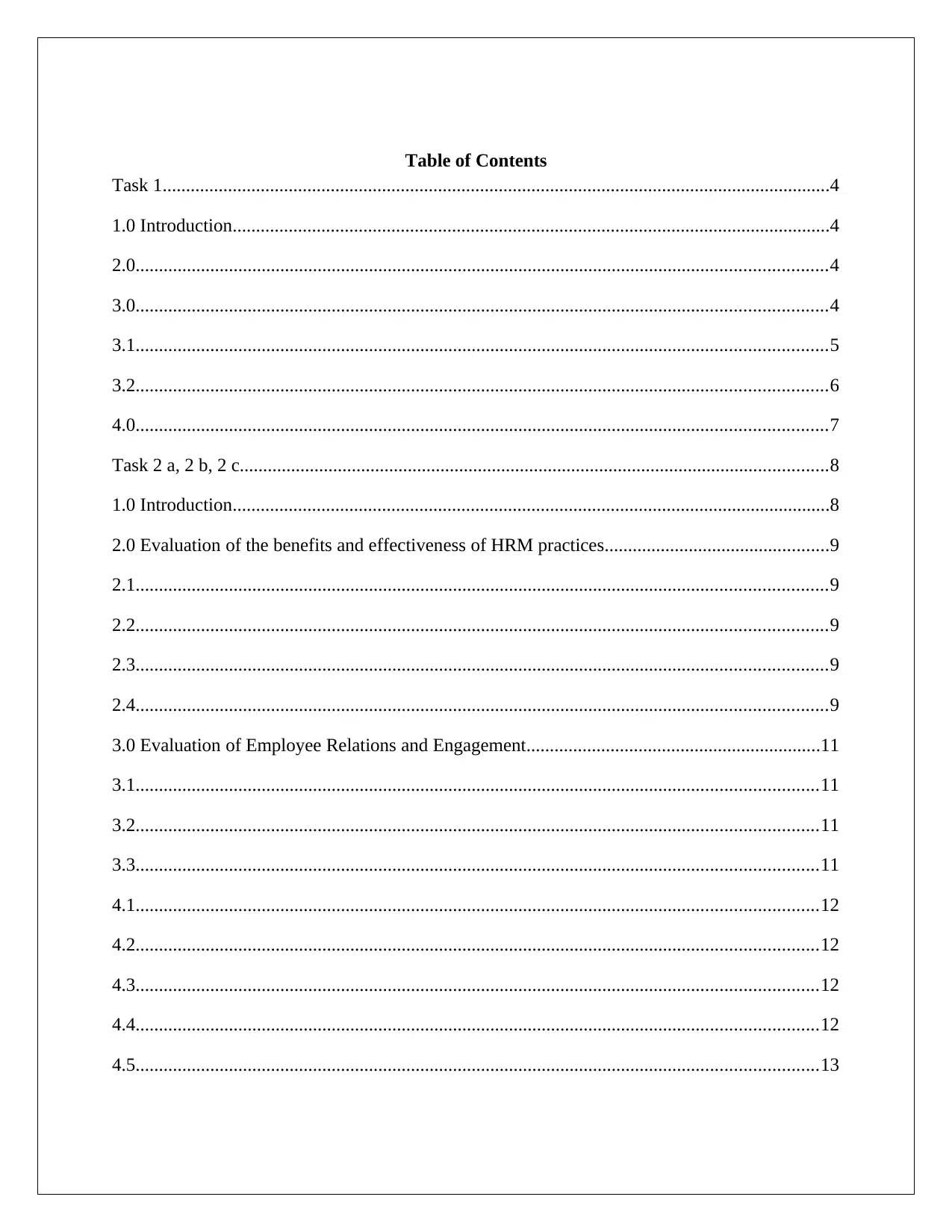
Table of Contents
Task 1...............................................................................................................................................4
1.0 Introduction................................................................................................................................4
2.0....................................................................................................................................................4
3.0....................................................................................................................................................4
3.1....................................................................................................................................................5
3.2....................................................................................................................................................6
4.0....................................................................................................................................................7
Task 2 a, 2 b, 2 c..............................................................................................................................8
1.0 Introduction................................................................................................................................8
2.0 Evaluation of the benefits and effectiveness of HRM practices................................................9
2.1....................................................................................................................................................9
2.2....................................................................................................................................................9
2.3....................................................................................................................................................9
2.4....................................................................................................................................................9
3.0 Evaluation of Employee Relations and Engagement...............................................................11
3.1..................................................................................................................................................11
3.2..................................................................................................................................................11
3.3..................................................................................................................................................11
4.1..................................................................................................................................................12
4.2..................................................................................................................................................12
4.3..................................................................................................................................................12
4.4..................................................................................................................................................12
4.5..................................................................................................................................................13
Task 1...............................................................................................................................................4
1.0 Introduction................................................................................................................................4
2.0....................................................................................................................................................4
3.0....................................................................................................................................................4
3.1....................................................................................................................................................5
3.2....................................................................................................................................................6
4.0....................................................................................................................................................7
Task 2 a, 2 b, 2 c..............................................................................................................................8
1.0 Introduction................................................................................................................................8
2.0 Evaluation of the benefits and effectiveness of HRM practices................................................9
2.1....................................................................................................................................................9
2.2....................................................................................................................................................9
2.3....................................................................................................................................................9
2.4....................................................................................................................................................9
3.0 Evaluation of Employee Relations and Engagement...............................................................11
3.1..................................................................................................................................................11
3.2..................................................................................................................................................11
3.3..................................................................................................................................................11
4.1..................................................................................................................................................12
4.2..................................................................................................................................................12
4.3..................................................................................................................................................12
4.4..................................................................................................................................................12
4.5..................................................................................................................................................13
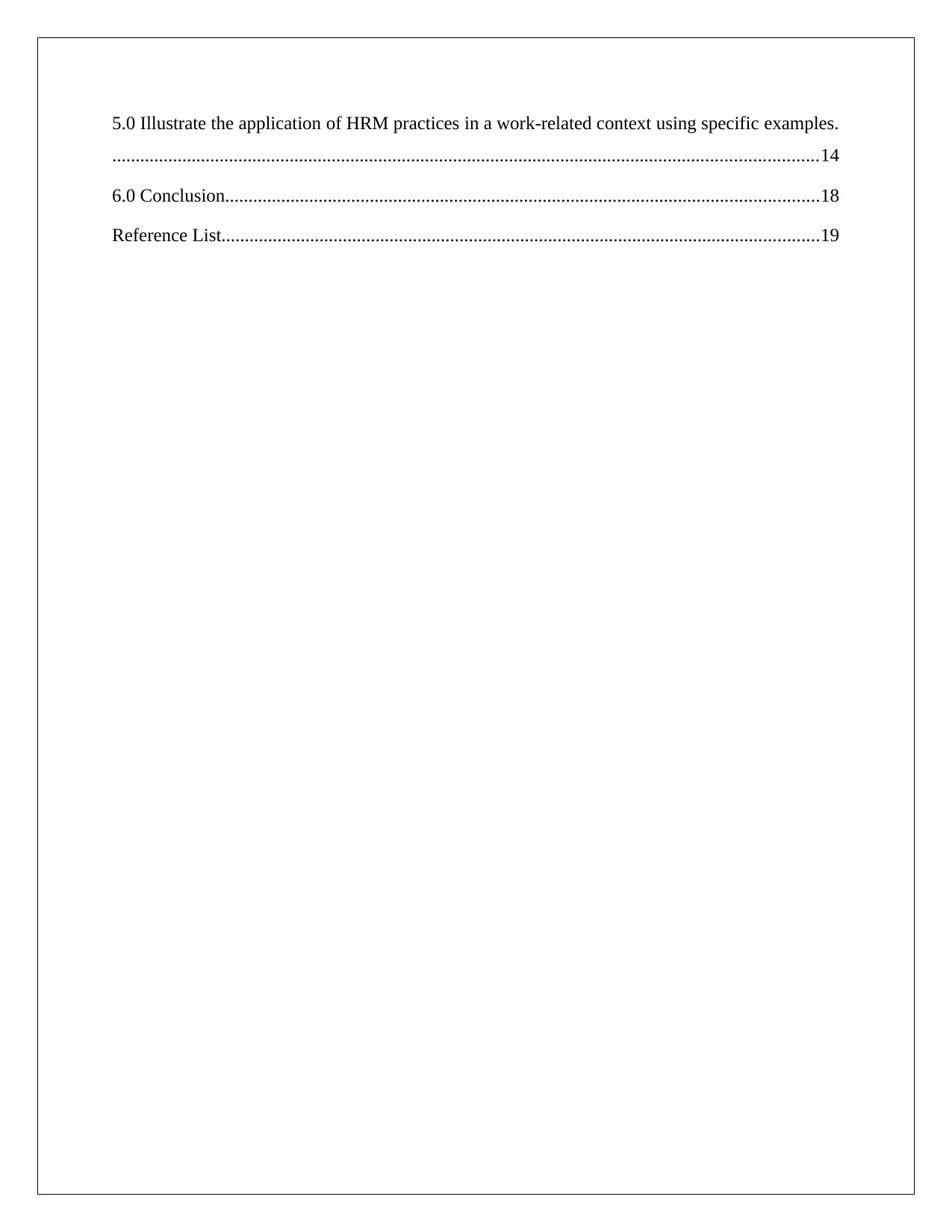
5.0 Illustrate the application of HRM practices in a work-related context using specific examples.
.......................................................................................................................................................14
6.0 Conclusion...............................................................................................................................18
Reference List................................................................................................................................19
.......................................................................................................................................................14
6.0 Conclusion...............................................................................................................................18
Reference List................................................................................................................................19
⊘ This is a preview!⊘
Do you want full access?
Subscribe today to unlock all pages.

Trusted by 1+ million students worldwide
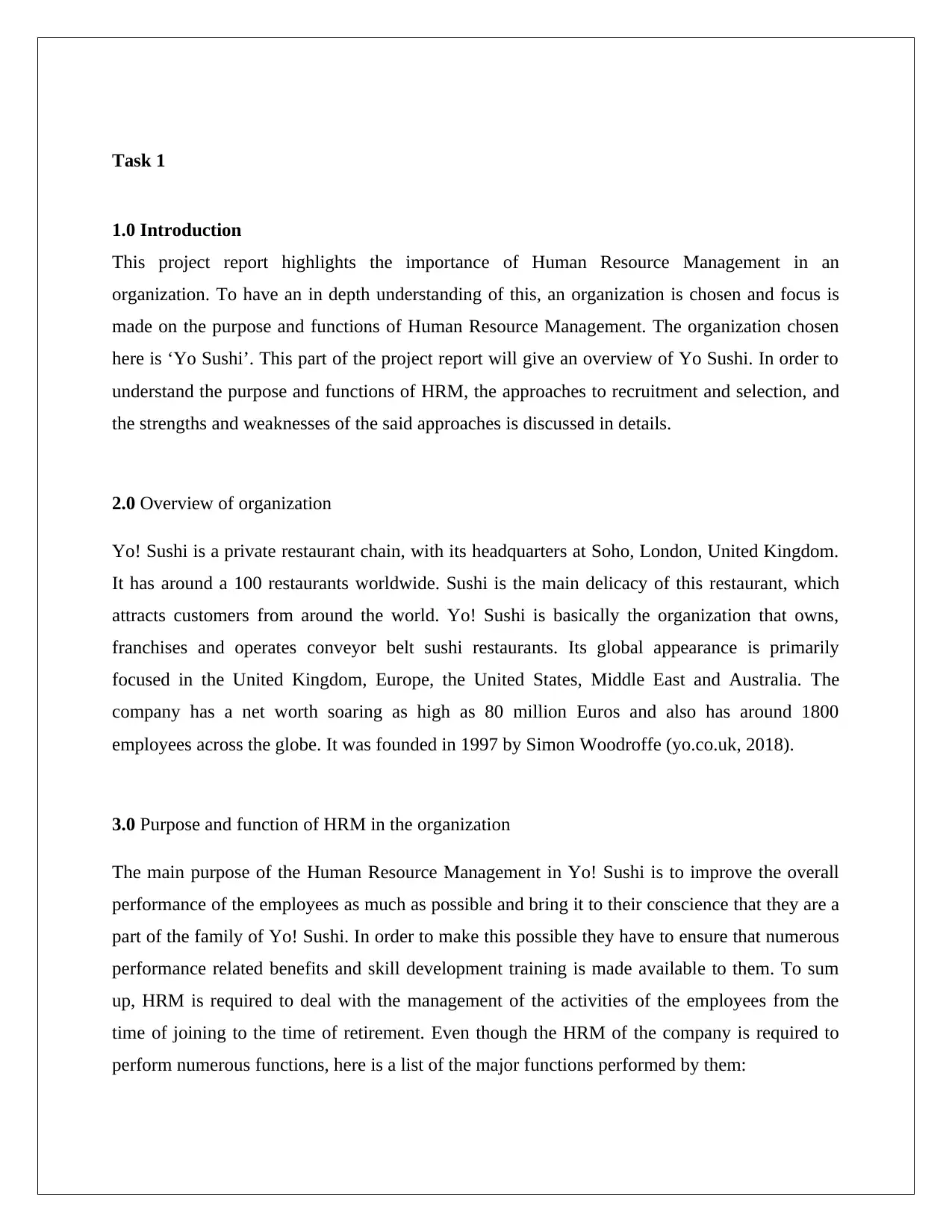
Task 1
1.0 Introduction
This project report highlights the importance of Human Resource Management in an
organization. To have an in depth understanding of this, an organization is chosen and focus is
made on the purpose and functions of Human Resource Management. The organization chosen
here is ‘Yo Sushi’. This part of the project report will give an overview of Yo Sushi. In order to
understand the purpose and functions of HRM, the approaches to recruitment and selection, and
the strengths and weaknesses of the said approaches is discussed in details.
2.0 Overview of organization
Yo! Sushi is a private restaurant chain, with its headquarters at Soho, London, United Kingdom.
It has around a 100 restaurants worldwide. Sushi is the main delicacy of this restaurant, which
attracts customers from around the world. Yo! Sushi is basically the organization that owns,
franchises and operates conveyor belt sushi restaurants. Its global appearance is primarily
focused in the United Kingdom, Europe, the United States, Middle East and Australia. The
company has a net worth soaring as high as 80 million Euros and also has around 1800
employees across the globe. It was founded in 1997 by Simon Woodroffe (yo.co.uk, 2018).
3.0 Purpose and function of HRM in the organization
The main purpose of the Human Resource Management in Yo! Sushi is to improve the overall
performance of the employees as much as possible and bring it to their conscience that they are a
part of the family of Yo! Sushi. In order to make this possible they have to ensure that numerous
performance related benefits and skill development training is made available to them. To sum
up, HRM is required to deal with the management of the activities of the employees from the
time of joining to the time of retirement. Even though the HRM of the company is required to
perform numerous functions, here is a list of the major functions performed by them:
1.0 Introduction
This project report highlights the importance of Human Resource Management in an
organization. To have an in depth understanding of this, an organization is chosen and focus is
made on the purpose and functions of Human Resource Management. The organization chosen
here is ‘Yo Sushi’. This part of the project report will give an overview of Yo Sushi. In order to
understand the purpose and functions of HRM, the approaches to recruitment and selection, and
the strengths and weaknesses of the said approaches is discussed in details.
2.0 Overview of organization
Yo! Sushi is a private restaurant chain, with its headquarters at Soho, London, United Kingdom.
It has around a 100 restaurants worldwide. Sushi is the main delicacy of this restaurant, which
attracts customers from around the world. Yo! Sushi is basically the organization that owns,
franchises and operates conveyor belt sushi restaurants. Its global appearance is primarily
focused in the United Kingdom, Europe, the United States, Middle East and Australia. The
company has a net worth soaring as high as 80 million Euros and also has around 1800
employees across the globe. It was founded in 1997 by Simon Woodroffe (yo.co.uk, 2018).
3.0 Purpose and function of HRM in the organization
The main purpose of the Human Resource Management in Yo! Sushi is to improve the overall
performance of the employees as much as possible and bring it to their conscience that they are a
part of the family of Yo! Sushi. In order to make this possible they have to ensure that numerous
performance related benefits and skill development training is made available to them. To sum
up, HRM is required to deal with the management of the activities of the employees from the
time of joining to the time of retirement. Even though the HRM of the company is required to
perform numerous functions, here is a list of the major functions performed by them:
Paraphrase This Document
Need a fresh take? Get an instant paraphrase of this document with our AI Paraphraser
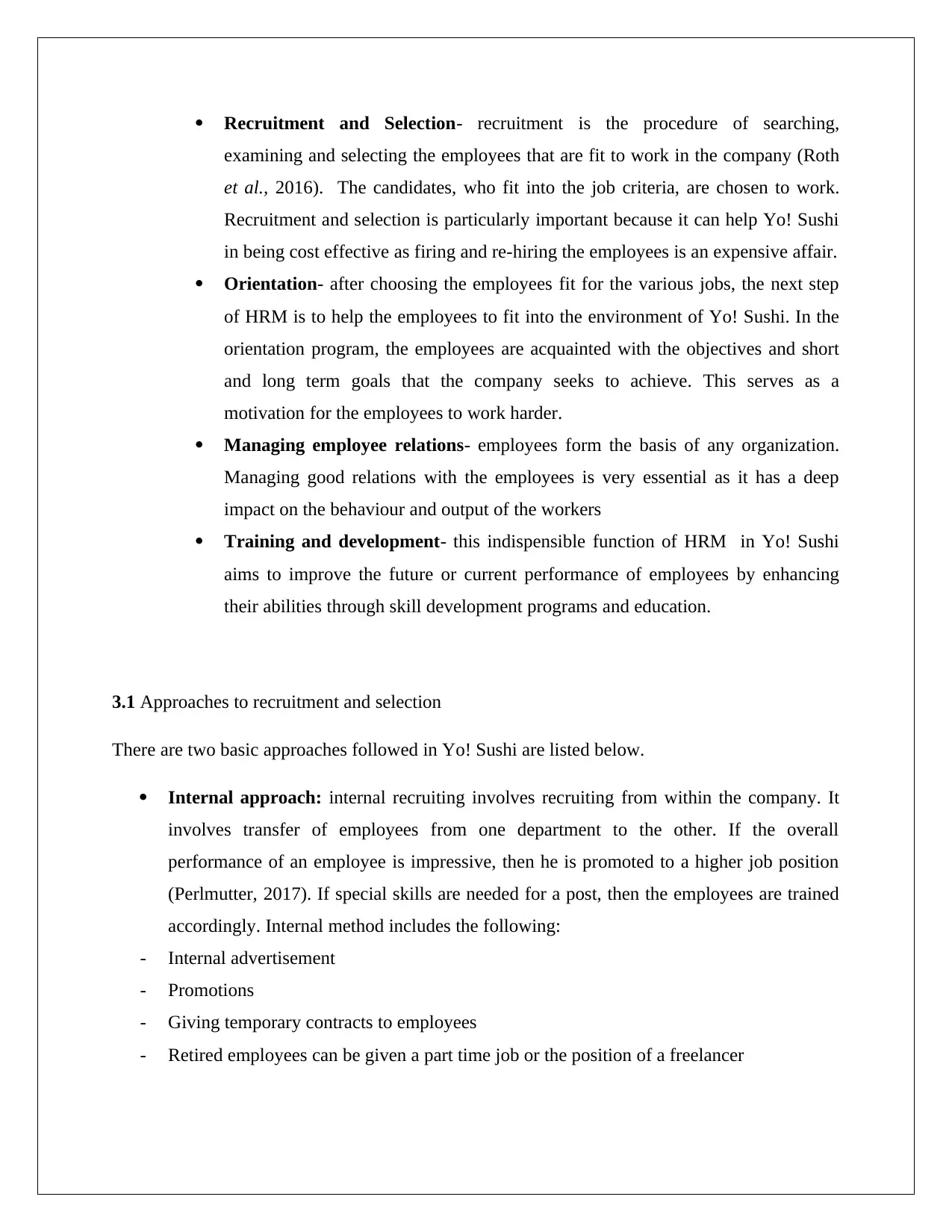
Recruitment and Selection- recruitment is the procedure of searching,
examining and selecting the employees that are fit to work in the company (Roth
et al., 2016). The candidates, who fit into the job criteria, are chosen to work.
Recruitment and selection is particularly important because it can help Yo! Sushi
in being cost effective as firing and re-hiring the employees is an expensive affair.
Orientation- after choosing the employees fit for the various jobs, the next step
of HRM is to help the employees to fit into the environment of Yo! Sushi. In the
orientation program, the employees are acquainted with the objectives and short
and long term goals that the company seeks to achieve. This serves as a
motivation for the employees to work harder.
Managing employee relations- employees form the basis of any organization.
Managing good relations with the employees is very essential as it has a deep
impact on the behaviour and output of the workers
Training and development- this indispensible function of HRM in Yo! Sushi
aims to improve the future or current performance of employees by enhancing
their abilities through skill development programs and education.
3.1 Approaches to recruitment and selection
There are two basic approaches followed in Yo! Sushi are listed below.
Internal approach: internal recruiting involves recruiting from within the company. It
involves transfer of employees from one department to the other. If the overall
performance of an employee is impressive, then he is promoted to a higher job position
(Perlmutter, 2017). If special skills are needed for a post, then the employees are trained
accordingly. Internal method includes the following:
- Internal advertisement
- Promotions
- Giving temporary contracts to employees
- Retired employees can be given a part time job or the position of a freelancer
examining and selecting the employees that are fit to work in the company (Roth
et al., 2016). The candidates, who fit into the job criteria, are chosen to work.
Recruitment and selection is particularly important because it can help Yo! Sushi
in being cost effective as firing and re-hiring the employees is an expensive affair.
Orientation- after choosing the employees fit for the various jobs, the next step
of HRM is to help the employees to fit into the environment of Yo! Sushi. In the
orientation program, the employees are acquainted with the objectives and short
and long term goals that the company seeks to achieve. This serves as a
motivation for the employees to work harder.
Managing employee relations- employees form the basis of any organization.
Managing good relations with the employees is very essential as it has a deep
impact on the behaviour and output of the workers
Training and development- this indispensible function of HRM in Yo! Sushi
aims to improve the future or current performance of employees by enhancing
their abilities through skill development programs and education.
3.1 Approaches to recruitment and selection
There are two basic approaches followed in Yo! Sushi are listed below.
Internal approach: internal recruiting involves recruiting from within the company. It
involves transfer of employees from one department to the other. If the overall
performance of an employee is impressive, then he is promoted to a higher job position
(Perlmutter, 2017). If special skills are needed for a post, then the employees are trained
accordingly. Internal method includes the following:
- Internal advertisement
- Promotions
- Giving temporary contracts to employees
- Retired employees can be given a part time job or the position of a freelancer
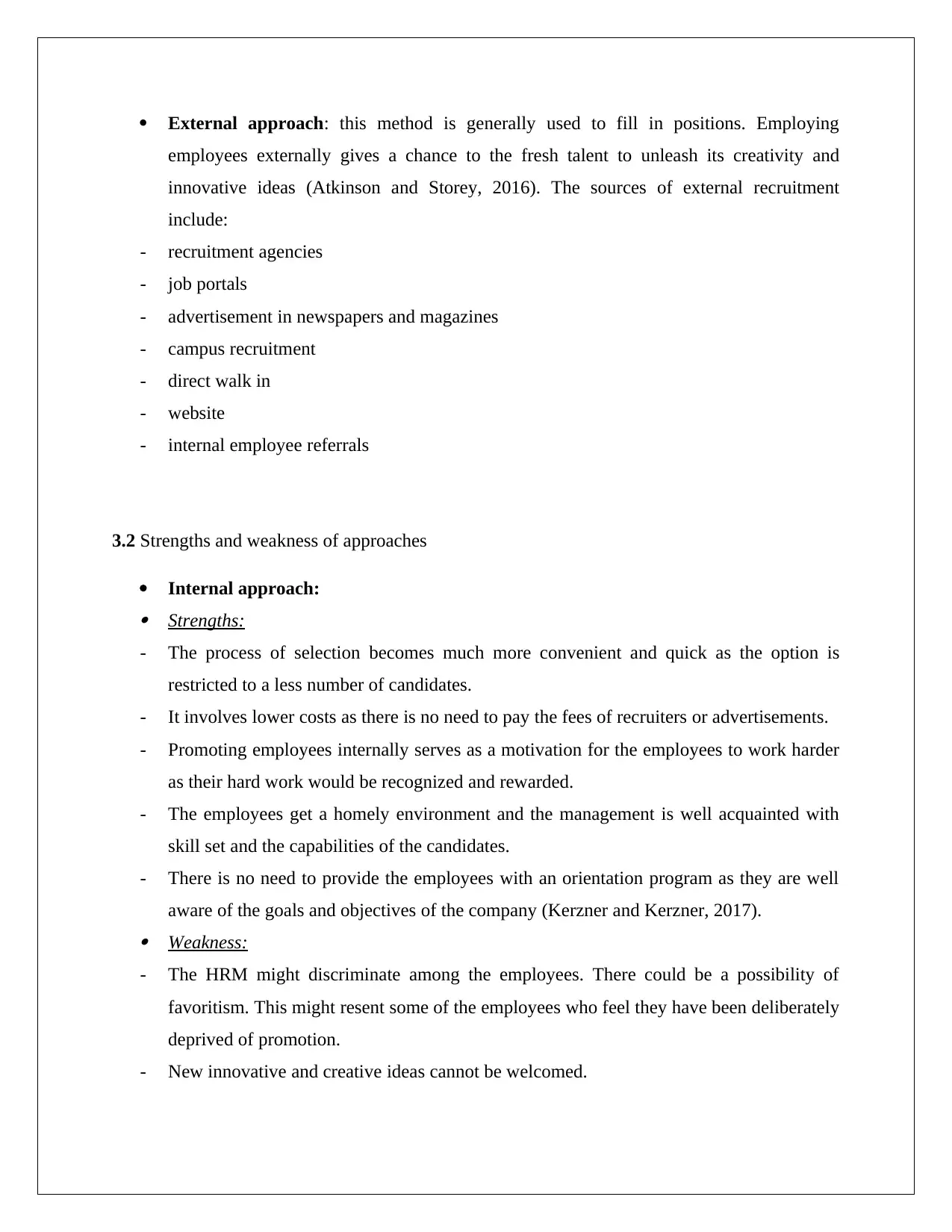
External approach: this method is generally used to fill in positions. Employing
employees externally gives a chance to the fresh talent to unleash its creativity and
innovative ideas (Atkinson and Storey, 2016). The sources of external recruitment
include:
- recruitment agencies
- job portals
- advertisement in newspapers and magazines
- campus recruitment
- direct walk in
- website
- internal employee referrals
3.2 Strengths and weakness of approaches
Internal approach: Strengths:
- The process of selection becomes much more convenient and quick as the option is
restricted to a less number of candidates.
- It involves lower costs as there is no need to pay the fees of recruiters or advertisements.
- Promoting employees internally serves as a motivation for the employees to work harder
as their hard work would be recognized and rewarded.
- The employees get a homely environment and the management is well acquainted with
skill set and the capabilities of the candidates.
- There is no need to provide the employees with an orientation program as they are well
aware of the goals and objectives of the company (Kerzner and Kerzner, 2017). Weakness:
- The HRM might discriminate among the employees. There could be a possibility of
favoritism. This might resent some of the employees who feel they have been deliberately
deprived of promotion.
- New innovative and creative ideas cannot be welcomed.
employees externally gives a chance to the fresh talent to unleash its creativity and
innovative ideas (Atkinson and Storey, 2016). The sources of external recruitment
include:
- recruitment agencies
- job portals
- advertisement in newspapers and magazines
- campus recruitment
- direct walk in
- website
- internal employee referrals
3.2 Strengths and weakness of approaches
Internal approach: Strengths:
- The process of selection becomes much more convenient and quick as the option is
restricted to a less number of candidates.
- It involves lower costs as there is no need to pay the fees of recruiters or advertisements.
- Promoting employees internally serves as a motivation for the employees to work harder
as their hard work would be recognized and rewarded.
- The employees get a homely environment and the management is well acquainted with
skill set and the capabilities of the candidates.
- There is no need to provide the employees with an orientation program as they are well
aware of the goals and objectives of the company (Kerzner and Kerzner, 2017). Weakness:
- The HRM might discriminate among the employees. There could be a possibility of
favoritism. This might resent some of the employees who feel they have been deliberately
deprived of promotion.
- New innovative and creative ideas cannot be welcomed.
⊘ This is a preview!⊘
Do you want full access?
Subscribe today to unlock all pages.

Trusted by 1+ million students worldwide
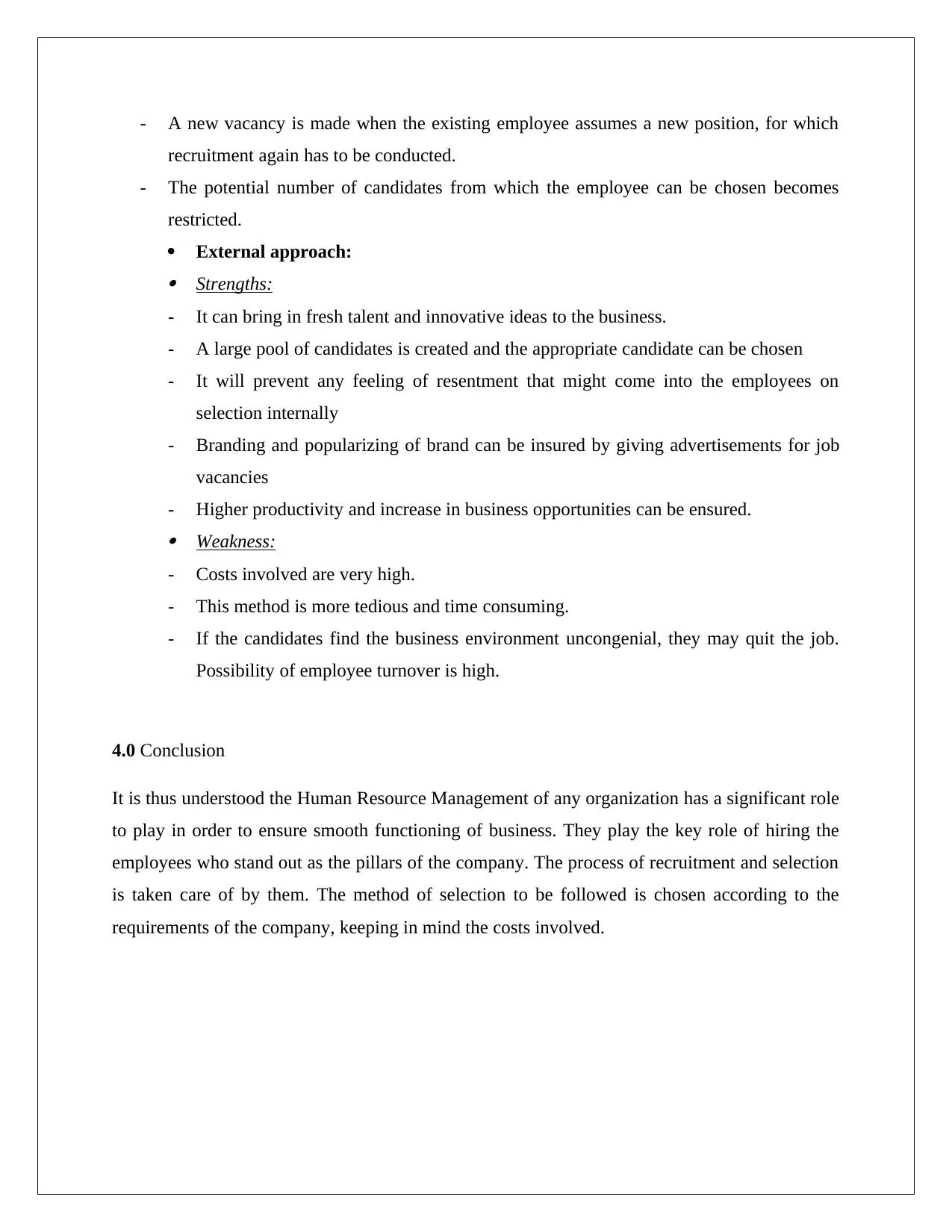
- A new vacancy is made when the existing employee assumes a new position, for which
recruitment again has to be conducted.
- The potential number of candidates from which the employee can be chosen becomes
restricted.
External approach:
Strengths:
- It can bring in fresh talent and innovative ideas to the business.
- A large pool of candidates is created and the appropriate candidate can be chosen
- It will prevent any feeling of resentment that might come into the employees on
selection internally
- Branding and popularizing of brand can be insured by giving advertisements for job
vacancies
- Higher productivity and increase in business opportunities can be ensured.
Weakness:
- Costs involved are very high.
- This method is more tedious and time consuming.
- If the candidates find the business environment uncongenial, they may quit the job.
Possibility of employee turnover is high.
4.0 Conclusion
It is thus understood the Human Resource Management of any organization has a significant role
to play in order to ensure smooth functioning of business. They play the key role of hiring the
employees who stand out as the pillars of the company. The process of recruitment and selection
is taken care of by them. The method of selection to be followed is chosen according to the
requirements of the company, keeping in mind the costs involved.
recruitment again has to be conducted.
- The potential number of candidates from which the employee can be chosen becomes
restricted.
External approach:
Strengths:
- It can bring in fresh talent and innovative ideas to the business.
- A large pool of candidates is created and the appropriate candidate can be chosen
- It will prevent any feeling of resentment that might come into the employees on
selection internally
- Branding and popularizing of brand can be insured by giving advertisements for job
vacancies
- Higher productivity and increase in business opportunities can be ensured.
Weakness:
- Costs involved are very high.
- This method is more tedious and time consuming.
- If the candidates find the business environment uncongenial, they may quit the job.
Possibility of employee turnover is high.
4.0 Conclusion
It is thus understood the Human Resource Management of any organization has a significant role
to play in order to ensure smooth functioning of business. They play the key role of hiring the
employees who stand out as the pillars of the company. The process of recruitment and selection
is taken care of by them. The method of selection to be followed is chosen according to the
requirements of the company, keeping in mind the costs involved.
Paraphrase This Document
Need a fresh take? Get an instant paraphrase of this document with our AI Paraphraser
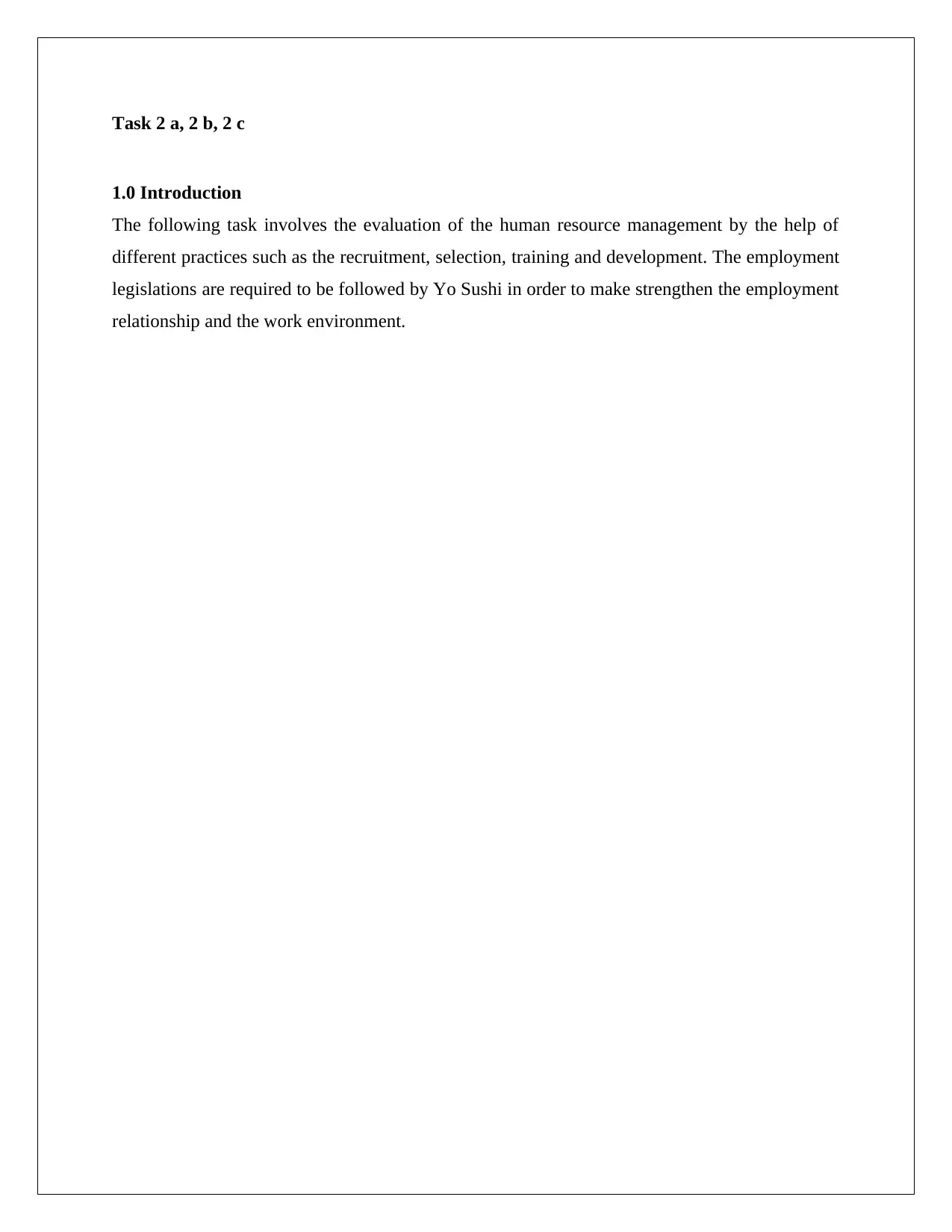
Task 2 a, 2 b, 2 c
1.0 Introduction
The following task involves the evaluation of the human resource management by the help of
different practices such as the recruitment, selection, training and development. The employment
legislations are required to be followed by Yo Sushi in order to make strengthen the employment
relationship and the work environment.
1.0 Introduction
The following task involves the evaluation of the human resource management by the help of
different practices such as the recruitment, selection, training and development. The employment
legislations are required to be followed by Yo Sushi in order to make strengthen the employment
relationship and the work environment.

2.0 Evaluation of the benefits and effectiveness of HRM practices
2.1 Workforce planning
The workforce planning refers to the ongoing process executed by the human resource
department of the organization in order to identify and fulfil the needs and requirements of the
employees for improving their efficiency in future along with strengthening their work
environment. Yo Sushi performs workforce planning by the help of several activities workforce
planning for the benefits of their employees and fulfilment of their targeted business objectives
in future.
2.2 Recruitment and selection
Recruitment and selection are very important practices of human resource management. The
recruitment and selection provide benefits to the employers and the employees in many ways. Yo
Sushi recruits employees from different colleges and universities. It conducts campus
recruitment to select, educated and skilled employees for its organization. Yo Sushi employs the
innovative and skilled employees into its organization to achieve business objectives and
improving its operations. The employees can gain employment recruitment, selection, and the
opportunity to portray their skills to represent positive results to the organization.
2.3 Training and development
Effective training and development are provided to the fresh and the existing employees in order
to make them work in organization effectively. Proper training and development enhances the
skills of the workforce and increases innovation in organization leading to the successful
development in the organization. Conducting effective training and development sessions helps
the Yo Sushi to improve its business operations and motivate its employees towards better
representation of performance results.
2.4 Performance Management and Reward Systems
Performance management involves several activities in and organization for evaluation of the
fulfilment of goals and objectives targeted by the organization (Dutra et al., 2015). This helps in
administration and improvement of the business operations and the performance of employees in
2.1 Workforce planning
The workforce planning refers to the ongoing process executed by the human resource
department of the organization in order to identify and fulfil the needs and requirements of the
employees for improving their efficiency in future along with strengthening their work
environment. Yo Sushi performs workforce planning by the help of several activities workforce
planning for the benefits of their employees and fulfilment of their targeted business objectives
in future.
2.2 Recruitment and selection
Recruitment and selection are very important practices of human resource management. The
recruitment and selection provide benefits to the employers and the employees in many ways. Yo
Sushi recruits employees from different colleges and universities. It conducts campus
recruitment to select, educated and skilled employees for its organization. Yo Sushi employs the
innovative and skilled employees into its organization to achieve business objectives and
improving its operations. The employees can gain employment recruitment, selection, and the
opportunity to portray their skills to represent positive results to the organization.
2.3 Training and development
Effective training and development are provided to the fresh and the existing employees in order
to make them work in organization effectively. Proper training and development enhances the
skills of the workforce and increases innovation in organization leading to the successful
development in the organization. Conducting effective training and development sessions helps
the Yo Sushi to improve its business operations and motivate its employees towards better
representation of performance results.
2.4 Performance Management and Reward Systems
Performance management involves several activities in and organization for evaluation of the
fulfilment of goals and objectives targeted by the organization (Dutra et al., 2015). This helps in
administration and improvement of the business operations and the performance of employees in
⊘ This is a preview!⊘
Do you want full access?
Subscribe today to unlock all pages.

Trusted by 1+ million students worldwide
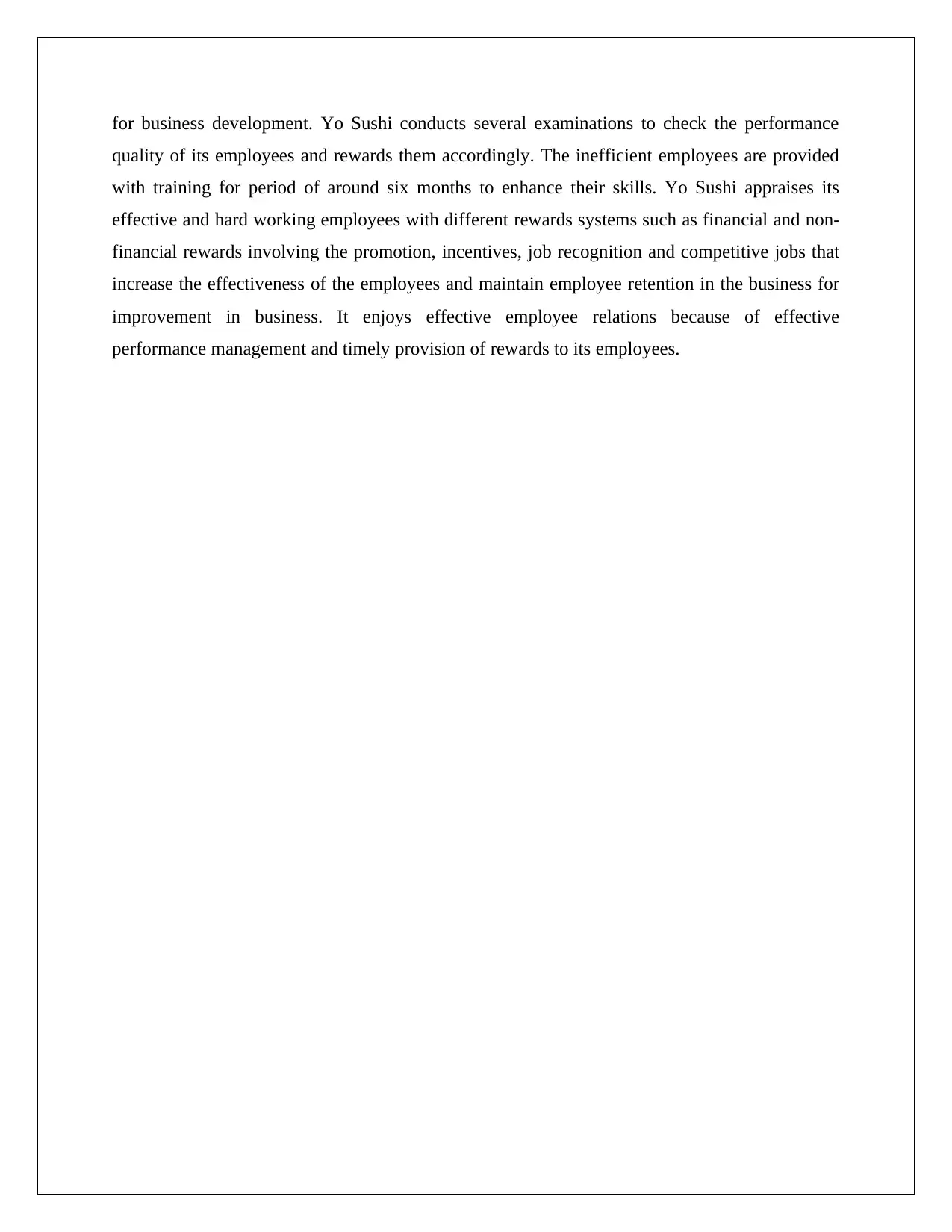
for business development. Yo Sushi conducts several examinations to check the performance
quality of its employees and rewards them accordingly. The inefficient employees are provided
with training for period of around six months to enhance their skills. Yo Sushi appraises its
effective and hard working employees with different rewards systems such as financial and non-
financial rewards involving the promotion, incentives, job recognition and competitive jobs that
increase the effectiveness of the employees and maintain employee retention in the business for
improvement in business. It enjoys effective employee relations because of effective
performance management and timely provision of rewards to its employees.
quality of its employees and rewards them accordingly. The inefficient employees are provided
with training for period of around six months to enhance their skills. Yo Sushi appraises its
effective and hard working employees with different rewards systems such as financial and non-
financial rewards involving the promotion, incentives, job recognition and competitive jobs that
increase the effectiveness of the employees and maintain employee retention in the business for
improvement in business. It enjoys effective employee relations because of effective
performance management and timely provision of rewards to its employees.
Paraphrase This Document
Need a fresh take? Get an instant paraphrase of this document with our AI Paraphraser

3.0 Evaluation of Employee Relations and Engagement
3.1 Importance of Employee Relations and Engagement
Effective employee relations play a significant role in the improvement of business performance.
The employees working at Yo Sushi are very effective and have effective relations with other
employees. Yo Sushi invites the opinions of employees in every significant matters of the
organizations. Effective employee relations at Yo Sushi leads to the strengthening of the work
environment, increase in the efficiency and innovation among employees’ work and reduce the
workplace conflicts in the organization. Proper employee relation is very necessary in Yo Sushi
for motivating its employees in order to work effectively and innovatively for representing the
impressive results to the organization. This leads to achievement of desired business objectives
of Yo Sushi. Sound employee relation eliminates the disruption in the workplace.
3.2 Flexible organization and Flexible Work Practices
Flexibility in the organization and work practices is very necessary is very important for smooth
functioning of company’s business. Employers should frame the work environment that is
suitable for the employees and where employees can work effectively (Scott, 2015). Yo Sushi
timely changes the work environment of its organization so that its employees do not consider
their work as burden. Changes in work timings of the employees’ increases their effectiveness
and motivation level leading to improvement work performance, improves business operations,
and reduces workplace conflicts. Flexibility in the work environment of Yo Sushi improves its
business operations and increase effectiveness as well as job loyalty of its employees.
3.3 Employer of Choice
It is very important for an employer to be the best choice of employees. Employer has to build
the skills also that the employees admire him and listen to his directions and instructions.
Management of Yo Sushi effectively communicates with its employees and timely resolves their
issues in order to create healthy relationship with them. This increases employee effectiveness,
increase in productivity as well as increased employee motivation and morale. One of the most
important reasons of improved business is the employers. Yo Sushi proves to be a good
employer who manages its employees successfully.
3.1 Importance of Employee Relations and Engagement
Effective employee relations play a significant role in the improvement of business performance.
The employees working at Yo Sushi are very effective and have effective relations with other
employees. Yo Sushi invites the opinions of employees in every significant matters of the
organizations. Effective employee relations at Yo Sushi leads to the strengthening of the work
environment, increase in the efficiency and innovation among employees’ work and reduce the
workplace conflicts in the organization. Proper employee relation is very necessary in Yo Sushi
for motivating its employees in order to work effectively and innovatively for representing the
impressive results to the organization. This leads to achievement of desired business objectives
of Yo Sushi. Sound employee relation eliminates the disruption in the workplace.
3.2 Flexible organization and Flexible Work Practices
Flexibility in the organization and work practices is very necessary is very important for smooth
functioning of company’s business. Employers should frame the work environment that is
suitable for the employees and where employees can work effectively (Scott, 2015). Yo Sushi
timely changes the work environment of its organization so that its employees do not consider
their work as burden. Changes in work timings of the employees’ increases their effectiveness
and motivation level leading to improvement work performance, improves business operations,
and reduces workplace conflicts. Flexibility in the work environment of Yo Sushi improves its
business operations and increase effectiveness as well as job loyalty of its employees.
3.3 Employer of Choice
It is very important for an employer to be the best choice of employees. Employer has to build
the skills also that the employees admire him and listen to his directions and instructions.
Management of Yo Sushi effectively communicates with its employees and timely resolves their
issues in order to create healthy relationship with them. This increases employee effectiveness,
increase in productivity as well as increased employee motivation and morale. One of the most
important reasons of improved business is the employers. Yo Sushi proves to be a good
employer who manages its employees successfully.
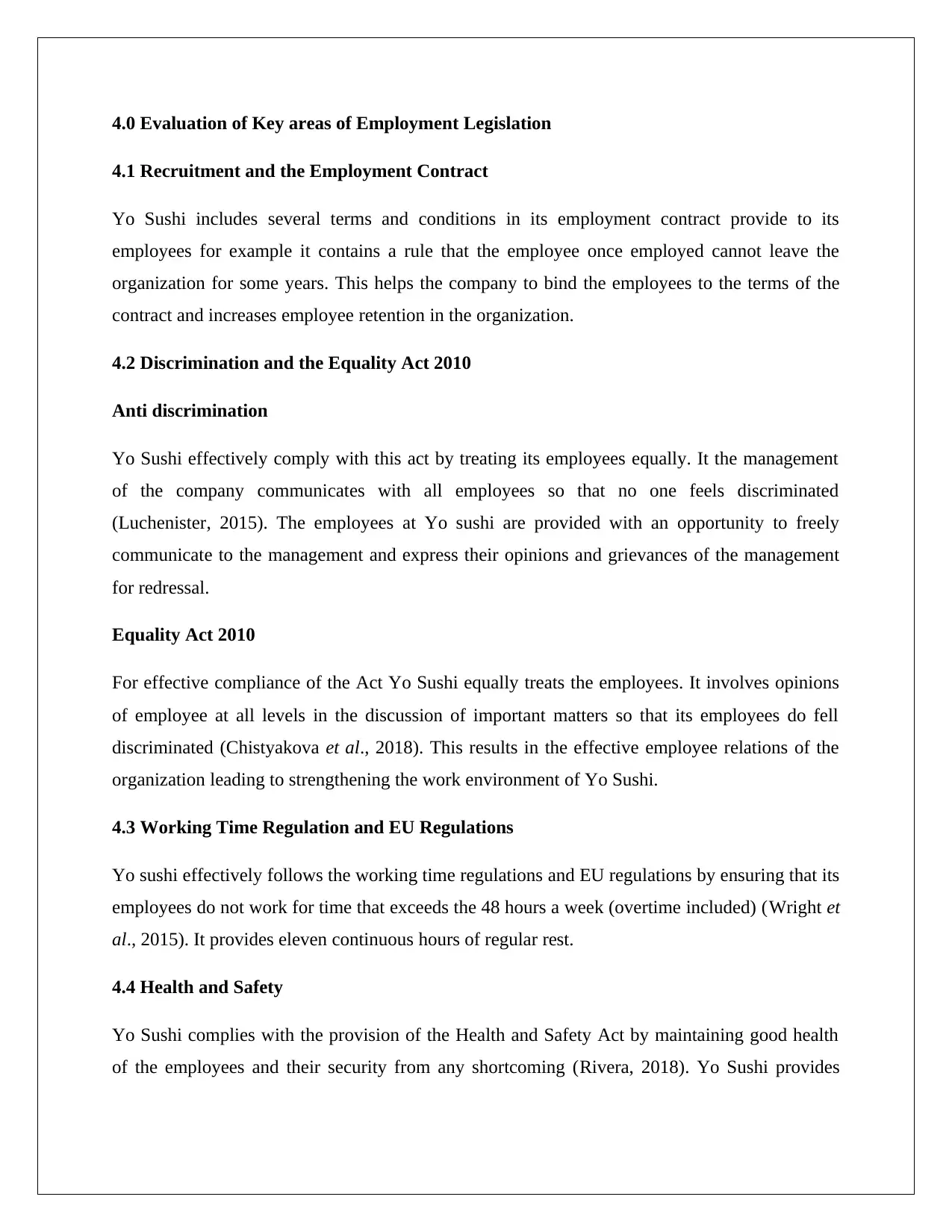
4.0 Evaluation of Key areas of Employment Legislation
4.1 Recruitment and the Employment Contract
Yo Sushi includes several terms and conditions in its employment contract provide to its
employees for example it contains a rule that the employee once employed cannot leave the
organization for some years. This helps the company to bind the employees to the terms of the
contract and increases employee retention in the organization.
4.2 Discrimination and the Equality Act 2010
Anti discrimination
Yo Sushi effectively comply with this act by treating its employees equally. It the management
of the company communicates with all employees so that no one feels discriminated
(Luchenister, 2015). The employees at Yo sushi are provided with an opportunity to freely
communicate to the management and express their opinions and grievances of the management
for redressal.
Equality Act 2010
For effective compliance of the Act Yo Sushi equally treats the employees. It involves opinions
of employee at all levels in the discussion of important matters so that its employees do fell
discriminated (Chistyakova et al., 2018). This results in the effective employee relations of the
organization leading to strengthening the work environment of Yo Sushi.
4.3 Working Time Regulation and EU Regulations
Yo sushi effectively follows the working time regulations and EU regulations by ensuring that its
employees do not work for time that exceeds the 48 hours a week (overtime included) (Wright et
al., 2015). It provides eleven continuous hours of regular rest.
4.4 Health and Safety
Yo Sushi complies with the provision of the Health and Safety Act by maintaining good health
of the employees and their security from any shortcoming (Rivera, 2018). Yo Sushi provides
4.1 Recruitment and the Employment Contract
Yo Sushi includes several terms and conditions in its employment contract provide to its
employees for example it contains a rule that the employee once employed cannot leave the
organization for some years. This helps the company to bind the employees to the terms of the
contract and increases employee retention in the organization.
4.2 Discrimination and the Equality Act 2010
Anti discrimination
Yo Sushi effectively comply with this act by treating its employees equally. It the management
of the company communicates with all employees so that no one feels discriminated
(Luchenister, 2015). The employees at Yo sushi are provided with an opportunity to freely
communicate to the management and express their opinions and grievances of the management
for redressal.
Equality Act 2010
For effective compliance of the Act Yo Sushi equally treats the employees. It involves opinions
of employee at all levels in the discussion of important matters so that its employees do fell
discriminated (Chistyakova et al., 2018). This results in the effective employee relations of the
organization leading to strengthening the work environment of Yo Sushi.
4.3 Working Time Regulation and EU Regulations
Yo sushi effectively follows the working time regulations and EU regulations by ensuring that its
employees do not work for time that exceeds the 48 hours a week (overtime included) (Wright et
al., 2015). It provides eleven continuous hours of regular rest.
4.4 Health and Safety
Yo Sushi complies with the provision of the Health and Safety Act by maintaining good health
of the employees and their security from any shortcoming (Rivera, 2018). Yo Sushi provides
⊘ This is a preview!⊘
Do you want full access?
Subscribe today to unlock all pages.

Trusted by 1+ million students worldwide
1 out of 25
Related Documents
Your All-in-One AI-Powered Toolkit for Academic Success.
+13062052269
info@desklib.com
Available 24*7 on WhatsApp / Email
![[object Object]](/_next/static/media/star-bottom.7253800d.svg)
Unlock your academic potential
Copyright © 2020–2025 A2Z Services. All Rights Reserved. Developed and managed by ZUCOL.




